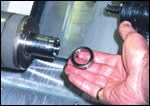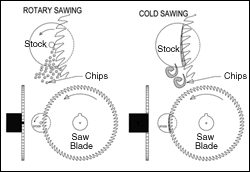Rotary Sawing Takes A Turn In Cutoff Operations
Although Rotary Saw Cutting (RSC) has been used in cutoff operations since the 1940s, the process is still relatively unknown. However, Watkins Manufacturing Inc. (Cincinnati, Ohio) is looking to enlighten more shops by showing them the benefits of their RSC systems known as SAW-lution Systems.
Although Rotary Saw Cutting (RSC) has been used in cutoff operations since the 1940s, the process is still relatively unknown. However, Watkins Manufacturing Inc. (Cincinnati, Ohio) is looking to enlighten more shops by showing them the benefits of their RSC systems known as SAW-lution Systems.
RSC uses a rotating, circular saw blade for cutting off, grooving and forming while the barstock is rotating. The keys that make RSC so effective are chip formation and low chip load. The rotation of both the saw and the barstock eliminates long, stringy chips associated with single-point cutting. Also, the saw nibbles away at the point of tangency of the part that is being cut off, creating small, granulated chips smaller than those produced when cold sawing. Because of the smaller chips, saws for RSC can have a much finer tooth configuration than saws for cold sawing. RSC’s low chip load and small chip formation allow heat to be dissipated more quickly; when the part is dropped, it and the saw blade are cool to the touch.
Featured Content
Watkins’ main focus is to promote the advantages of rotary sawing over single-point tooling in cutoff operations. Fritz Greulich, president of Watkins, explains that this method can generate more parts per hour, more parts per bar, easier and less costly scrap handling, increased tool life, better part finishes and dimensional repeatability. He states that in rotary sawing, “The saw can be fed two to four times faster per revolution of the work than single-point tooling, and at one third of the thickness of the single-point tool. This leads to the ability to cut off more quickly and leads to substantial material savings—and the shorter the part, the more savings involved.”
To go along with the thinner cutoff and faster cuts, RSC also offers a surface finish worth mentioning. According to Mr. Greulich, the quality of the cut, as measured by a profilometer, is generally better than that of the single-point cutoff tool. Although the finish looks different, with tool marks tending to be like a Blanchard grind with a swirling pattern from the center to the outside, the surface is flatter, held within 0.002 inch, even when cutting difficult-to-machine materials. Squareness and parallelism are better as well because of the lack of deflection during the cut.
When cutting into a hole, RSC results in much less burr. Also, the burr is flimsy, not rolled into the hole as in single-point cutting. Watkins often cuts samples for potential customers. Mr. Greulich knows that RSC will not cut a burr-free part, but when customers see the results, they initially believe the part has been touched up after the cutoff. While making a shaft or any part without a hole, RSC allows cutting to center without leaving a cutoff nib.
RSC can also increase machine capabilities. It is good for thin-wall tubing because of low cutting pressure; the integrity of the part is not disturbed while performing the cutoff. Rotary sawing can be used to replace some forming operations as well. Mr. Greulich mentioned one case in which a saw replaced a forming tool and has been cutting for a year and a half, having only been sharpened twice. Forming with a saw also typically allows much faster feed rates than when using a single-edge tool.
Most turning machines can be fitted with RSC fairly easily. The modular design permits adaptation to a variety of host machines or jobs simply by changing the radial orientation of motor to gearbox or cutter head, by reversing the saw spindle or by changing mounting devices or saws. Standrdized attachments and parts are available to fit most multi-spindle and single-spindle automatic screw machines. Electrical interfaces are also available from Watkins.
The initial investment of a system, which is considerably higher than that of single-point cutoff, should not prevent a company from considering RSC. Most systems pay for themselves within 6 months, and many system purchases are justified by material savings alone (even with an inexpensive material such as 12L14). On a recent job, one Watkins customer was cutting 12L14 parts of 2.25 inches in diameter and 0.4 inch long on one machine. By switching to RSC, they saved $80,000 the first year in materials alone. Did they feel it was worth the investment? Definitely.
Mr. Greulich points out that RSC is not limited to screw machines. He says people don’t generally think of cutting off with a saw when using CNC turning machines with live tooling. But with live tooling, there’s hardly any cost in getting started. He says, “Using your live tooling station, all you need is the circular saw—no system or interfaces are needed.” Watkins continues testing applications in this area, but so far it has seen no issues.
Saw materials, geometry and treatment have improved considerably through the years, increasing saw life and capabilities. Saws are available in high speed steel, super steels and solid carbide. Various surface treatments, such as Liquid Nitride and Titanium Nitride, increase saw life and produce even better surface finishes. Extensive testing has been done to determine the most effective saw geometry for specific applications, including the thickness, side clearance, cutoff angle, rake angle and number of teeth.
With potential advantages, such as increased production levels, lower production costs and improved part quality, RSC has become an important option in helping users reach the full capabilities of their turning machines.









